D-Link DSL-504T User Manual

DSL-504T
ADSL Router
User’s Guide
March 2005
651SL504T045
i

DSL-504T DSL Router User’s Guide
FCC Warning
This equipment has been tested and found to comply with the limits for a Class A digital device, pursuant to Part 15 of the FCC Rules. These limits are designed to provide reasonable protection against harmful interference when the equipment is operated in a commercial environment. This equipment generates, uses, and can radiate radio frequency energy and, if not installed and used in accordance with this user’s guide, may cause harmful interference to radio communications. Operation of this equipment in a residential area is likely to cause harmful interference in which case the user will be required to correct the interference at his own expense.
CE Mark Warning
This is a Class A product. In a domestic environment, this product may cause radio interference in which case the user may be required to take adequate measures.
ii

TABLE OF CONTENTS
About This User’s Guide ................................................................................................. |
v |
BEFORE YOU START............................................................................................... |
V |
Installation Overview.............................................................................................................................................. |
v |
The Setup Wizard.......................................................................................................... |
v |
INSTALLATION REQUIREMENTS .......................................................................... |
VI |
PACKING LIST ....................................................................................................... |
VIII |
INTRODUCTION ......................................................................................................... |
1 |
Router Description and Operation .................................................................................... |
1 |
Standards Compatibility and Compliance........................................................................... |
3 |
Front Panel Display ....................................................................................................... |
4 |
Rear Panel Connections.................................................................................................. |
5 |
HARDWARE INSTALLATION .................................................................................... |
6 |
Power on Router ........................................................................................................... |
6 |
Factory Reset Button ..................................................................................................... |
6 |
Network Connections ..................................................................................................... |
7 |
BASIC ROUTER CONFIGURATION .......................................................................... |
9 |
Configuring IP Settings on Your Computer......................................................................... |
9 |
Access the Configuration Manager ................................................................................................................... |
15 |
Login to Home Page .................................................................................................... |
15 |
Configure the Router............................................................................................................................................ |
16 |
Using the Setup Wizard................................................................................................ |
17 |
Configure WAN Connection ................................................................................................................................ |
21 |
PPPoE and PPPoA Connection for WAN ............................................................................ |
22 |
Bridged Connection for WAN ......................................................................................... |
23 |
Static IP Address for WAN ............................................................................................ |
24 |
LAN IP Settings..................................................................................................................................................... |
25 |
DHCP Server Settings for the LAN...................................................................................................................... |
26 |
DNS Server Settings.................................................................................................... |
27 |
Save Settings and Reboot ................................................................................................................................... |
28 |
Multiple Virtual Connections ............................................................................................................................... |
29 |
ADVANCED ROUTER MANAGEMENT ................................................................... |
31 |
UPnP......................................................................................................................... |
32 |
Port Forwarding .......................................................................................................... |
33 |
DMZ ......................................................................................................................... |
35 |
Filters ....................................................................................................................... |
36 |
Firewall ..................................................................................................................... |
38 |
NAT .......................................................................................................................... |
39 |
ATM.......................................................................................................................... |
40 |
Static Routing ............................................................................................................ |
42 |
Dynamic Routing (RIP) ................................................................................................ |
43 |
Remote Access ........................................................................................................... |
44 |
Tools...................................................................................................................................................................... |
45 |
Change System Password............................................................................................. |
45 |

Save or Load Configuration File ..................................................................................... |
46 |
Restore Factory Default Settings.................................................................................... |
46 |
Time......................................................................................................................... |
47 |
Firmware................................................................................................................... |
48 |
Test.......................................................................................................................... |
49 |
Save & Reboot............................................................................................................ |
50 |
Status Information................................................................................................................................................ |
51 |
Device Information Display ........................................................................................... |
51 |
DHCP Clients.............................................................................................................. |
51 |
Log........................................................................................................................... |
52 |
Traffic ....................................................................................................................... |
53 |
ADSL ........................................................................................................................ |
54 |
TECHNICAL SPECIFICATIONS............................................................................... |
55 |
IP ADDRESS SETUP................................................................................................ |
57 |
IP CONCEPTS .......................................................................................................... |
59 |
MICROFILTERS AND SPLITTERS .......................................................................... |
62 |

DSL-504T DSL Router User’s Guide
About This User’s Guide
This user’s guide provides instructions on how to install the DSL-504T ADSL Router and use it to provide Internet access for an Ethernet LAN.
If you are using a computer with a functioning Ethernet port, the quickest and easiest way to set up the DSL-504T is to follow the instructions provided in the Quick Installation Guide.
Before You Start
Please read and make sure you understand all the prerequisites for proper installation of your new Router. Have all the necessary information and equipment on hand before beginning the installation.
Installation Overview
The procedure to install the Router can be described in general terms in the following steps:
1.Gather information and equipment needed to install the device. Before you begin the actual installation make sure you have all the necessary information and equipment.
2.Install the hardware, connect the cables to the device and connect the power adapter.
3.Check the IP settings on your computer and change them if necessary so the computer can access the web-based software built into the Router.
4.Use the web-based management software to configure the device to suit the requirements of your ADSL service and private network.
The Setup Wizard
Many users will be able to configure all the settings necessary to use the DSL-504T with the Setup Wizard. For most ADSL users, the simplest way to setup the DSL-504T is to use the Setup Wizard to configure the Internet connection. Once you access the web interface used to configure the device, just launch the Setup Wizard to configure your Internet connection.
v

DSL-504T DSL Router User’s Guide
Installation Requirements
In order to establish a connection to the Internet it will be necessary to provide information to the Router that will be stored in its memory. For some users, only their account information (Username and Password) is required. For others, various parameters that control and define the Internet connection will be required. You can print out the two pages below and use the tables to list this information. This way you have a hard copy of all the information needed to setup the Router. If it is necessary to reconfigure the device, all the necessary information can be easily accessed. Be sure to keep this information safe and private.
Low Pass Filters
Since ADSL and telephone services share the same copper wiring to carry their respective signals, a filtering mechanism may be necessary to avoid mutual interference. A low pass filter device can be installed for each telephone that shares the line with the ADSL line. These filters are easy to install passive devices that connect to the ADSL device and/or telephone using standard telephone cable. Ask your service provider for more information about the use of low pass filters with your installation.
Operating Systems
The DSL-504T uses an HTML-based web interface for setup and management. The web configuration manager may be accessed using any operating system capable of running web browser software, including Windows 98 SE, Windows ME, Windows 2000, and Windows XP.
Web Browser
Any common web browser can be used to configure the Router using the web configuration management software. The program is designed to work best with more recently released browsers such as Opera, Microsoft Internet Explorer® version 5.0, Netscape Navigator® version 4.7, or later versions. The web browser must have JavaScript enabled. JavaScript is enabled by default on many browsers. Make sure JavaScript has not been disabled by other software (such as virus protection or web user security packages) that may be running on your computer.
Ethernet Port (NIC Adapter)
Any computer that uses the Router must be able to connect to it through the Ethernet port on the Router. This connection is an Ethernet connection and therefore requires that your computer be equipped with an Ethernet port as well. Most notebook computers are now sold with an Ethernet port already installed. Likewise, most fully assembled desktop computers come with an Ethernet NIC adapter as standard equipment. If your computer does not have an Ethernet port, you must install an Ethernet NIC adapter before you can use the Router. If you must install an adapter, follow the installation instructions that come with the Ethernet NIC adapter.
Additional Software
It may be necessary to install software on your computer that enables the computer to access the Internet. Additional software must be installed if you are using the device a simple bridge. For a bridged connection, the information needed to make and maintain the Internet connection is stored on another computer or gateway device, not in the Router itself.
If your ADSL service is delivered through a PPPoE, PPPoA or Static IP connection, the information needed to establish and maintain the Internet connection can be stored in the Router. In this case, it is not necessary to install software on your computer. It may however be necessary to change some settings in the device, including account information used to identify and verify the connection.
vi

DSL-504T DSL Router User’s Guide
Information you will need from your ADSL service provider:
|
This is the Username used to log on to your ADSL |
Record info here |
Username |
service provider’s network. It is commonly in the |
|
form − user@isp.com. Your ADSL service provider |
|
|
|
|
|
|
uses this to identify your account. |
|
|
|
|
|
This is the Password used, in conjunction with the |
|
Password |
Username above, to log on to your ADSL service |
|
provider’s network. This is used to verify the identity |
|
|
|
|
|
|
of your account. |
|
|
|
|
|
This is the method your ADSL service provider uses |
|
|
to transport data between the Internet and your |
|
|
computer. Most users will use the default |
|
|
PPPoE/PPPoA, connection type. The Setup Wizard can |
|
|
be used to configure a PPPoE/PPPoA connection type. |
|
Connection and |
You may need to specify one of the following |
|
connection types (PPPoE LLC, PPPoA LLC or PPPoA |
|
|
Encapsulation Type |
VC-MUX). The other available connection and |
|
|
encapsulation combinations must be configured using |
|
|
the web manager. These include Bridge Mode (1483 |
|
|
Bridged IP LLC or 1483 Bridged IP VC-MUX), and |
|
|
Static IP (Bridged IP LLC, 1483 Bridged IP VC-MUX, |
|
|
1483 Routed IP LLC, 1483 Routed IP VC-MUX or |
|
|
IPoA). |
|
|
|
|
|
Most users will not be required to change this setting. |
|
|
The Virtual Path Identifier (VPI) is used in conjunction |
|
|
with the Virtual Channel Identifier (VCI) to identify |
|
|
the data path between your ADSL service provider’s |
|
VPI |
network and your computer. If you are setting up the |
|
Router for multiple virtual connections, you will need |
|
|
|
|
|
|
to configure the VPI and VCI as instructed by your |
|
|
ADSL service provider for the additional connections. |
|
|
This setting can be changed in the WAN menu of the |
|
|
web management interface. |
|
|
|
|
|
Most users will not be required to change this setting. |
|
|
The Virtual Channel Identifier (VCI) used in |
|
|
conjunction with the VPI to identify the data path |
|
|
between your ADSL service provider’s network and |
|
VCI |
your computer. If you are setting up the Router for |
|
multiple virtual connections, you will need to |
|
|
|
|
|
|
configure the VPI and VCI as instructed by your ADSL |
|
|
service provider for the additional connections. This |
|
|
setting can be changed in the WAN menu of the web |
|
|
management interface. |
|
|
|
|
The Setup Wizard can be used to configure the Internet connection for most users. If you are using a PPPoE or PPPoA type connection use the Setup Wizard to establish the Internet
Note connection.
vii
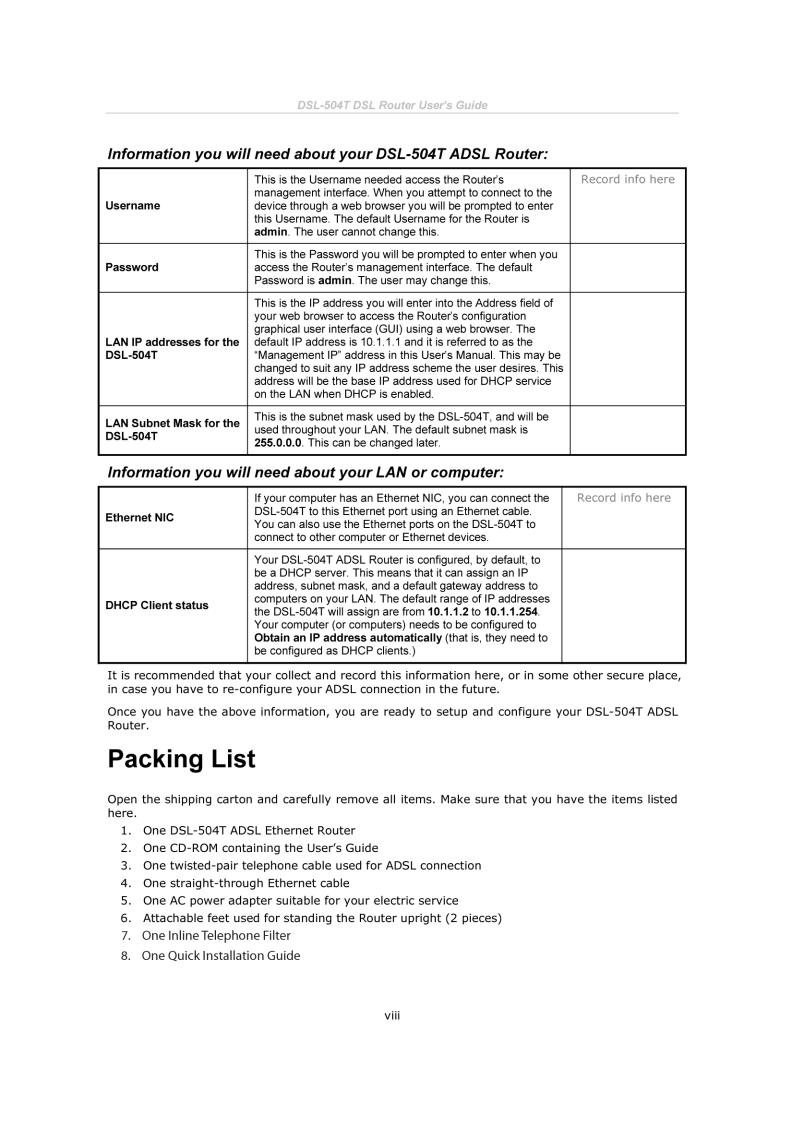

DSL-504T DSL Router User’s Guide
1
Introduction
This section provides a brief description of the Router, its associated technologies and a list of Router features.
Router Description and Operation
The DSL-504T ADSL Router is designed to provide a simple and cost-effective ADSL Internet connection for individual computers through the Ethernet ports, or use it to bridge your Ethernet LAN to the Internet. The DSL-504T combines the benefits of high-speed ADSL technology and LAN IP management in one compact and convenient package. ADSL technology enables many interactive multi-media applications such as video conferencing and collaborative computing.
The Router is easy to install and use. The DSL-504T connects to computers or an Ethernet LAN via a standard Ethernet interface. The ADSL connection is made using ordinary twisted-pair telephone line with standard connectors. Multiple PCs can be networked and connected to the Internet using a single Wide Area Network (WAN) interface and single global IP address.
The Router supports transparent bridging and can be used for IP packet routing over the Internet. Cost saving features of the Router such as NAT (Network Address Translator) and DHCP (Dynamic Host Configuration Protocol) improve administration efficiency and improve security for your private network. The advanced security enhancements, packet filtering and port redirection, can help protect your network from potentially devastating intrusions by malicious agents from outside your network.
What is ADSL?
Asymmetric Digital Subscriber Line (ADSL) is an access technology that utilizes ordinary copper telephone lines to enable broadband high-speed digital data transmission and interactive multimedia applications for business and residential customers.
ADSL greatly increases the signal carrying capacity of copper telephone lines without interfering with regular telephone services. For the ADSL user, this means faster downloads and more reliable connectivity. ADSL devices make it possible to enjoy benefits such as high-speed Internet access without experiencing any loss of quality or disruption of voice/fax telephone capabilities.
ADSL provides a dedicated service over a single telephone line operating at speeds of up to 8 Mbps downstream and up to 640 Kbps upstream, depending on local telephone line conditions. A secure point-to-point connection is established between the user and the central office of the service provider.
D-Link ADSL devices incorporate the recommendations of the ADSL Forum regarding framing, data format, and upper layer protocols.
1

DSL-504T DSL Router User’s Guide
Router Features
The DSL-504T ADSL Router utilizes the latest ADSL enhancements to provide a reliable Internet portal suitable for most small to medium sized offices. DSL-504T advantages include:
∙PPP (Point-to-Point Protocol) Security – The DSL-504T ADSL Router supports PAP (Password Authentication Protocol) and CHAP (Challenge Handshake Authentication Protocol) for PPP connections.
∙DHCP Support – Dynamic Host Configuration Protocol automatically and dynamically assigns al LAN IP settings to each host on your network. This eliminates the need to reconfigure every host whenever changes in network topology occur.
∙Network Address Translation (NAT) – For small office environments, the DSL-504T allows multiple users on the LAN to access the Internet concurrently through a single Internet account. This provides Internet access to everyone in the office for the price of a single user.
NAT improves network security in effect by hiding the private network behind one global and visible IP address. NAT address mapping can also be used to link two IP domains via a LAN-to- LAN connection.
∙TCP/IP (Transfer Control Protocol/Internet Protocol) – The DSL-504T supports TCP/IP protocol, the language used for the Internet. It is compatible with access servers manufactured by major vendors.
∙RIP – The DSL-504T supports RIP (RIP V1 compatible) to exchange routing information with other routers.
∙Static Routing – This allows you to select a data path to a particular network destination that will remain in the routing table and never “age out”. If you wish to define a specific route that will always be used for data traffic from your LAN to a specific destination within your LAN (for example to another router or a server) or outside your network (to a ISP defined default gateway for instance).
∙Default Routing – This allows you to choose a default path for incoming data packets for which the destination address is unknown. This is particularly useful when if the Router functions as the sole connection to the Internet.
∙ATM (Asynchronous Transfer Mode) – The DSL-504T supports Bridged Ethernet over ATM (RFC1483), IP over ATM (RFC1577) and PPP over ATM (RFC 2364).
∙Precise ATM Traffic Shaping – Traffic shaping is a method of controlling the flow rate of ATM data cells. This function helps to establish the Quality of Service for ATM data transfer.
∙G.hs (Auto-handshake) – This allows the Router to automatically choose either the G.lite or G.dmt ADSL connection standards.
∙High Performance – Very high rates of data transfer are possible with the Router. Up to eight Mbps downstream bit rate using the G.dmt.
∙Full Network Management – The DSL-504T incorporates SNMP (Simple Network Management Protocol) support for web-based management and text-based network management via an RS-232 or Telnet connection.
∙Telnet Connection – The Telnet enables a network manager to access the Router’s management software remotely.
∙Easy Installation – The DSL-504T uses a web-based graphical user interface program for convenient management access and easy set up. Any common web browser software can be used to manage the Router.
2

DSL-504T DSL Router User’s Guide
Standards Compatibility and Compliance
The DSL-504T complies with or is compatible with the following standards as recognized by their respective agencies.
∙ITU G.992.2 (G.lite “Splitterless ADSL”) compliant
∙ITU-T Rec. I.361 compliant
∙RFC 791 Internet Protocol compliant
∙RFC 792 UDP compliant
∙RFC 826 Address Resolution Protocol compliant (ARP) compliant
∙RFC 1058 Routing Information Protocol (RIP) compliant
∙RFC 1213 MIB II for IP compliant
∙RFC 1334 PPP Authentication Protocol compliant
∙RFC 1389 Routing Information Protocol 2 (RIP2) compliant
∙RFC 1483 IP over AAL5/ Bridged Ethernet over AAL5 compliant
∙RFC 1557 Classical IP over ATM (IPoA) compliant
∙RFC 1661 Point to Point Protocol (PPP) compliant
∙RFC 1877 Automatic IP assignment compliant
∙RFC 1994 Challenge Handshake Authentication Protocol compliant
∙Supports RFC 2131 and RFC 2132 DHCP functions including: automatic assignment of IP address, subnet mask and default gateway and provision of DNS server address for all hosts
∙RFC 2364 PPP over ATM compliant (PPPoA) compliant
∙RFC 2516 PPP over Ethernet compliant (PPPoE) compliant
∙RFC 2684 Bridged/Routed Ethernet over ATM compliant
∙IEEE 802.3 compliant
∙IEEE 802.3u compliant
∙IEEE 802.1d compliant
∙IEEE 802.3x compliant
∙Embedded web server support
∙Supports Dynamic Learning
∙Supports Static Routing
∙Supports NAPT for up to 4096 connections
∙Supports DHCP for up to 253 hot connections
∙Supports IGMP
∙Supports ATM Forum UNI 3.1/4.0
∙Supports ATM VCC (Virtual Channel Circuit) for up to eight sessions
∙Supports TELNET and TFTP
∙Supports back pressure for half-duplex
3
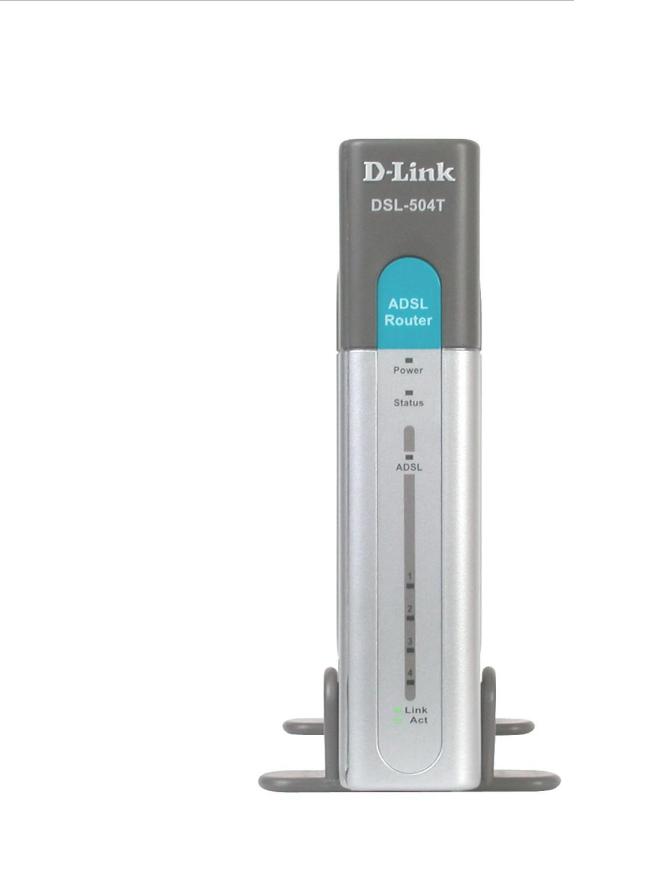
DSL-504T DSL Router User’s Guide
Front Panel Display
Place the Router in a location that permits an easy view of the LED indicators on the front panel.
The LED indicators on the front panel include the Power, Status, ADSL Link/Act and LAN (1-4) Link/Act indicators. The ADSL and Ethernet indicators monitor link status and activity (Link/Act).
|
|
|
Steady green light |
|
|
|
indicates the unit is |
|
Power |
|
powered on. When the |
|
|
|
device is powered off |
|
|
|
this remains dark. |
|
|
|
Lights steady green |
|
|
|
during power on self- |
|
|
|
test (POST). Once the |
|
|
|
connection status has |
|
|
|
been settled, the light |
|
Status |
|
will blink green. If the |
|
|
|
indicator lights steady |
|
|
|
green after the POST, |
|
|
|
the system has failed |
|
|
|
and the device should |
|
|
|
be rebooted. |
|
|
|
Steady green light |
|
|
|
indicates a valid ADSL |
|
|
|
connection. This will |
|
ADSL |
|
light after the ADSL |
|
Link/Act |
|
negotiation process has |
|
|
been settled. A blinking |
|
|
|
|
green light indicates |
|
|
|
activity on the WAN |
|
|
|
(ADSL) interface. |
|
|
|
A solid green light |
|
|
|
indicates a valid link on |
|
1 – 4 (Ethernet) |
|
startup. These lights |
|
Link/Act |
|
blink when there is |
|
|
activity currently |
|
|
|
|
passing through the |
|
|
|
Ethernet port. |
|
|
|
|
4
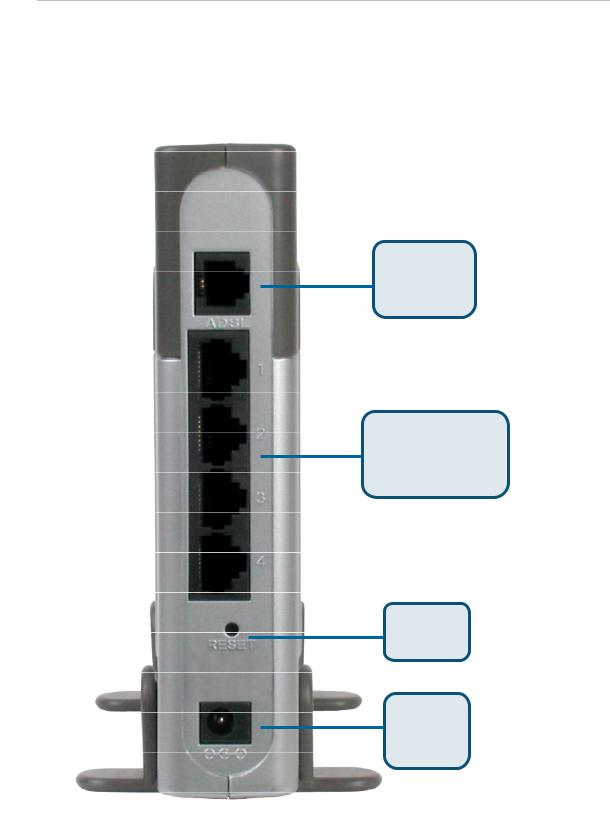
DSL-504T DSL Router User’s Guide
Rear Panel Connections
All cable connections to the Router are made at the rear panel. Connect the power adapter here to power on the Router. Use the Reset button to restore the settings to the factory default values.
ADSL port-
Connect to
ADSL line
Ethernet portsConnect to Ethernet cable
Factory
Reset button
Power input - connect to power adapter
5

DSL-504T DSL Router User’s Guide
2
Hardware Installation
The DSL-504T maintains five separate interfaces, four switched Ethernet ports and one ADSL interface. Place the Router in a location where it can be easily connected to the various devices as well as to a power source. The Router should not be located where it will be exposed to moisture or excessive heat. Make sure the cables and power cord are placed safely out of the way so they do not create a tripping hazard. As with any electrical appliance, observe common sense safety precautions.
The Router can be placed on a shelf or desktop, ideally you should be able to see the LED indicators on the front if you need to view them for troubleshooting. To conserve desktop space, the Router is shipped with plastic feet that can be snapped into place to support it. The Front and Rear panel views presented above show the device mounted using the plastic feet.
Power on Router
CAUTION: The Router must be used with the power adapter included with the device.
To power on the Router:
1.Connect the power adapter shipped with the Router to the power recepticle on the back panel of the device.
2.Plug the power adapter to an suitable electrical wall outlet or power strip.
3.Toggle the power switch on the back panel to power on the Router. The Power LED on the front of the Router will light green indicating it is powered on.
Factory Reset Button
The Router may be reset to the original factory default settings by depressing the reset button for a few seconds while the device is powered on. Use a ballpoint pen or paperclip to gently push down the reset button. Hold the reset button down until the Status light goes dark. Remember that this will wipe out any settings stored in flash memory including user account information and LAN IP settings. The factory default IP address of the Router is 10.1.1.1 and the subnet mask is 255.0.0.0, the default management Username is admin and the default Password is admin.
6

DSL-504T DSL Router User’s Guide
Network Connections
Network connections are provided through the ADSL port and the four Ethernet ports on the back of the Router. See the Rear Panel diagram above and the illustrations below for examples.
Connect ADSL Line
Use the ADSL cable included with the Router to connect it to a telephone wall socket or receptacle. Plug one end of the cable into the ADSL port (RJ-11 receptacle) on the rear panel of the Router and insert the other end into the RJ-11 wall socket. If you are using a low pass filter device, follow the instructions included with the device or given to you by your service provider. The ADSL connection represents the WAN interface, the connection to the Internet. It is the physical link to the service provider’s network backbone and ultimately to the Internet.
Connect Router to Ethernet
The Router may be connected to computers or Ethernet devices through the 10BASE-TX Ethernet ports on the rear panel. Any connection to an Ethernet concentrating device such as a switch or hub must operate at a speed of 10/100 Mbps only. When connecting the Router to any Ethernet device that is capable of operating at speeds higher than 10Mbps, be sure that the device has auto-negotiation (NWay) enabled for the connecting port.
Use standard twisted-pair cable with RJ-45 connectors. The RJ-45 port on the Router is a crossed port (MDI-X). Follow standard Ethernet guidelines when deciding what type of cable to use to make this connection. When connecting the Router directly to a computer or server use a normal straight-through cable. You should use a crossed cable when connecting the Router to a normal (MDI-X) port on a switch or hub. Use a normal straight-through cable when connecting it to an uplink (MDI-II) port on a hub or switch.
The rules governing Ethernet cable lengths apply to the LAN to Router connection. Be sure that the cable connecting the LAN to the Router does not exceed 100 meters.
7
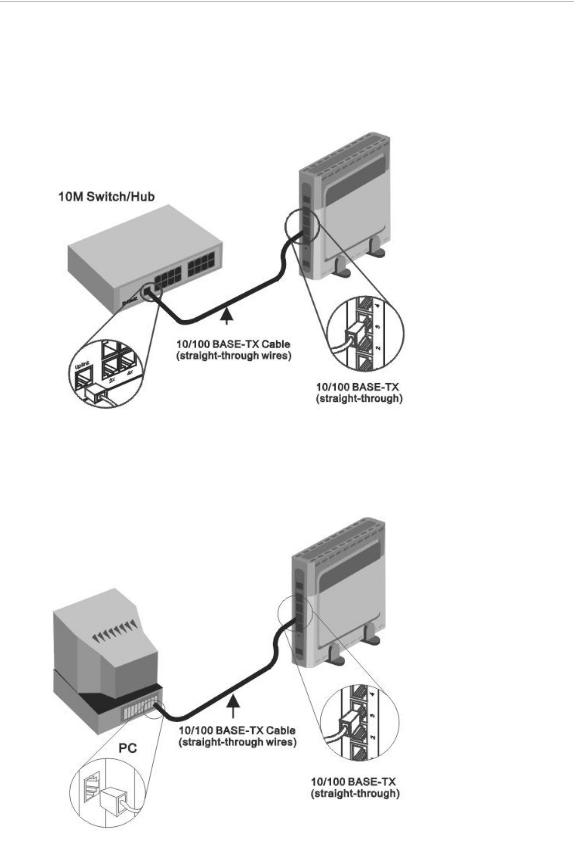
DSL-504T DSL Router User’s Guide
Hub or Switch to Router Connection
Connect the Router to an uplink port on an Ethernet hub or switch with a straight-through cable as shown in the diagram below:
If you wish to reserve the uplink port on the switch or hub for another device, connect to any on the other MDI-X ports (1x, 2x, etc.) with a crossed cable.
Computer to Router Connection
You can connect the Router directly to a 10/100BASE-TX Ethernet adapter card (NIC) installed on a PC using the Ethernet cable provided as shown in this diagram.
8

DSL-504T DSL Router User’s Guide
3
Basic Router Configuration
The first time you setup the Router it is recommended that you configure the WAN connection using a single computer connected directly to the Router. Once the WAN connection is functioning properly, you may continue to make changes to Router configuration including IP settings and DHCP setup.
Wan Configuration Summary
1.Connect to the Router To configure the WAN connection used by the Router it is first necessary to communicate with the Router through its management interface, which is HTML-based and can be accessed using a web browser. To access the management software your computer must be able to “see” the Router. Your computer can see the Router if it is in the same “neighborhood”or subnet as the Router. This is accomplished by making sure your computer has IP settings that place it in the same subnet as the Router. The easiest way to make sure your computer has the correct IP settings is to configure it to use the DHCP server in the Router. The section below describes how to change the IP configuration for a computer running a Windows operating system to be a DHCP client.
2.Configure the WAN Connection Once your are able to access the configuration software you can proceed to change the settings required to establish the ADSL connection and connect to the service provider’s network. There are different methods used to establish the connection to the service provider’s network and ultimately to the Internet. You should know what connection type you are required to use for your ADSL service. It is also possible that you must change the PVC settings used for the ADSL connection. Your service provider should provide all the information you need to configure the WAN connection.
Configuring IP Settings on Your Computer
In order to configure your system to receive IP settings from the Router it must first have the TCP/IP protocol installed. If you have an Ethernet port on your computer, it probably already has TCP/IP protocol installed. If you are using Windows XP the TCP/IP is enabled by default for standard installations. Below is an illustrated example of how to configure a Windows XP system to automatically obtain IP settings from the Router. Following this example is a step-by-step description of the procedures used on the other Windows operating systems to first check if the TCP/IP protocol has been installed; if it is not, instructions are provided for installing it. Once the protocol has been installed you can configure the system to receive IP settings from the Router.
For computers running non-Windows operating systems, follow the instructions for your OS that configure the system to receive an IP address from the Router, that is, configure the system to be a DHCP client.
|
|
|
If you are using this Router to provide Internet access for more than one computer, you can use |
|
|
|
|
these instructions later to change the IP settings for the other computers. Using DHCP will ensure |
|
|
|
|
|
|
|
|
|
|
|
|
|
that the IP addresses assigned to each workstation is unique and able to connect to the Router. |
|
|
Note |
|
|
|
|
|
|
|
|
|
9

DSL-504T DSL Router User’s Guide
Configure Windows XP for DHCP
Use the following steps to configure a computer running Windows XP to be a DHCP client.
1.From the Start menu on your desktop, go to Settings, then click on Network Connections.
2.In the Network Connections window, right-click on LAN (Local Area Connection), then click Properties.
10
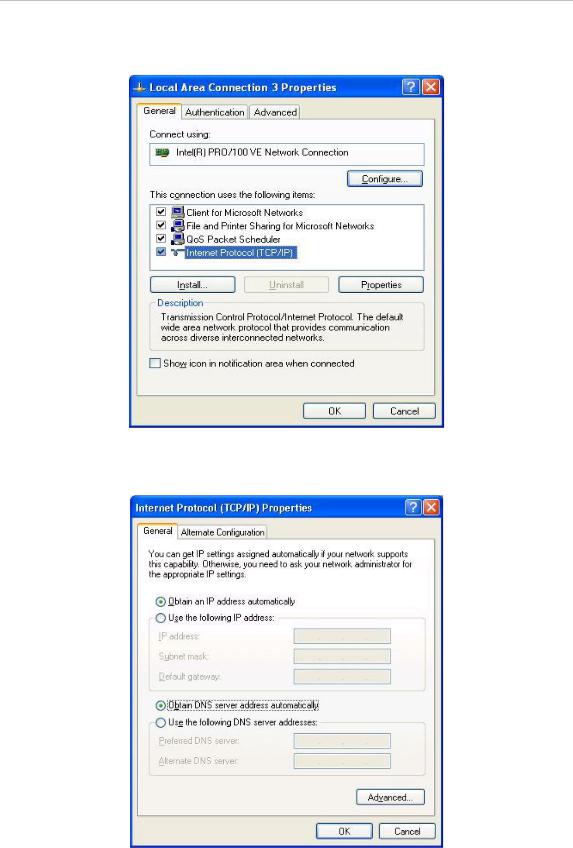
DSL-504T DSL Router User’s Guide
3. In the General tab of the Local Area Connection Properties menu, highlight Internet Protocol (TCP/IP) under “This connection uses the following items:” by clicking on it once. Click on the Properties button.
4.Select “Obtain an IP address automatically” by clicking once in the circle. Click the OK button.
Your computer is now ready to use the Router’s DHCP server.
11

DSL-504T DSL Router User’s Guide
Windows 2000
First, check for the IP protocol and, if necessary, install it:
1.In the Windows task bar, click the Start button, point to Settings, and then click Control Panel.
2.Double-click the Network and Dial-up Connections icon.
3.In the Network and Dial-up Connections window, right-click the Local Area Connection icon, and then select Properties.
4.The Local Area Connection Properties dialog box displays with a list of currently installed network components. If the list includes Internet Protocol (TCP/IP), then the protocol has already been enabled, skip ahead to Configure Windows 2000 for DHCP.
5.If Internet Protocol (TCP/IP) does not display as an installed component, click Install.
6.In the Select Network Component Type dialog box, select Protocol, and then click Add.
7.Select Internet Protocol (TCP/IP) in the Network Protocols list, and then click OK.
8.You may be prompted to install files from your Windows 2000 installation CD or other media. Follow the instructions to install the files.
9.If prompted, click OK to restart your computer with the new settings.
Configure Windows 2000 for DHCP
1.In the Control Panel, double-click the Network and Dial-up Connections icon.
2.In Network and Dial-up Connections window, right-click the Local Area Connection icon, and then select Properties.
3.In the Local Area Connection Properties dialog box, select Internet Protocol (TCP/IP), and then click Properties.
4.In the Internet Protocol (TCP/IP) Properties dialog box, click the button labeled
Obtain an IP address automatically.
5.Double-click OK to confirm and save your changes, and then close the Control Panel.
Your computer is now ready to use the Router’s DHCP server.
Windows ME
First, check for the IP protocol and, if necessary, install it:
1.In the Windows task bar, click the Start button, point to Settings, and then click Control Panel.
2.Double-click the Network and Dial-up Connections icon.
3.In the Network and Dial-up Connections window, right-click the Network icon, and then select Properties.
4.The Network Properties dialog box displays with a list of currently installed network components. If the list includes Internet Protocol (TCP/IP), then the protocol has already been enabled. Skip ahead to Configure Windows ME for DHCP.
5.If Internet Protocol (TCP/IP) does not display as an installed component, click Add.
6.In the Select Network Component Type dialog box, select Protocol, and then click Add.
7.Select Microsoft in the Manufacturers box.
8.Select Internet Protocol (TCP/IP) in the Network Protocols list, and then click OK.
9.You may be prompted to install files from your Windows Me installation CD or other media. Follow the instructions to install the files.
10.If prompted, click OK to restart your computer with the new settings.
12

DSL-504T DSL Router User’s Guide
Configure Windows ME for DHCP
1.In the Control Panel, double-click the Network and Dial-up Connections icon.
2.In the Network and Dial-up Connections window, right-click the Network icon, and then select Properties.
3.In the Network Properties dialog box, select TCP/IP, and then click Properties.
4.In the TCP/IP Settings dialog box, click the Obtain and IP address automatically option.
5.Double-click OK twice to confirm and save your changes, and then close the Control Panel. Your computer is now ready to use the Router’s DHCP server.
Windows 95 and Windows 98
First, check for the IP protocol and, if necessary, install it:
1.In the Windows task bar, click the Start button, point to Settings, and then click Control Panel. Double-click the Network icon.
2.The Network dialog box displays with a list of currently installed network components. If the list includes TCP/IP, and then the protocol has already been enabled, skip to Configure IP Information Windows 95, 98.
3.If TCP/IP does not display as an installed component, click Add. The Select Network Component Type dialog box displays.
4.Select Protocol, and then click Add. The Select Network Protocol dialog box displays.
5.Click on Microsoft in the Manufacturers list box, and then click TCP/IP in the Network Protocols list box.
6.Click OK to return to the Network dialog box, and then click OK again. You may be prompted to install files from your Windows 95/98 installation CD. Follow the instructions to install the files.
7.Click OK to restart the PC and complete the TCP/IP installation.
Configure Windows 95 and Windows 98 for DHCP
1.Open the Control Panel window, and then click the Network icon.
2.Select the network component labeled TCP/IP, and then click Properties.
3.If you have multiple TCP/IP listings, select the listing associated with your network card or adapter.
4.In the TCP/IP Properties dialog box, click the IP Address tab.
5.Click the Obtain an IP address automatically option.
6.Double-click OK to confirm and save your changes. You will be prompted to restart Windows.
7.Click Yes.
When it has restarted, your computer is ready to use the Router’s DHCP server.
13

DSL-504T DSL Router User’s Guide
Windows NT 4.0 Workstations
First, check for the IP protocol and, if necessary, install it:
1.In the Windows NT task bar, click the Start button, point to Settings, and then click
Control Panel.
2.In the Control Panel window, double-click the Network icon.
3.In the Network dialog box, click the Protocols tab.
4.The Protocols tab displays a list of currently installed network protocols. If the list includes TCP/IP, then the protocol has already been enabled. Skip to “Configure IP Information”
5.If TCP/IP does not display as an installed component, click Add.
6.In the Select Network Protocol dialog box, select TCP/IP, and then click OK. You may be prompted to install files from your Windows NT installation CD or other media. Follow the instructions to install the files.
7.After all files are installed, a window displays to inform you that a TCP/IP service called DHCP can be set up to dynamically assign IP information.
8.Click Yes to continue, and then click OK if prompted to restart your computer.
Configure Windows NT 4.0 for DHCP
1.Open the Control Panel window, and then double-click the Network icon.
2.In the Network dialog box, click the Protocols tab.
3.In the Protocols tab, select TCP/IP, and then click Properties.
4.In the Microsoft TCP/IP Properties dialog box, click the Obtain an IP address automatically option.
5.Click OK twice to confirm and save your changes, and then close the Control Panel.
14
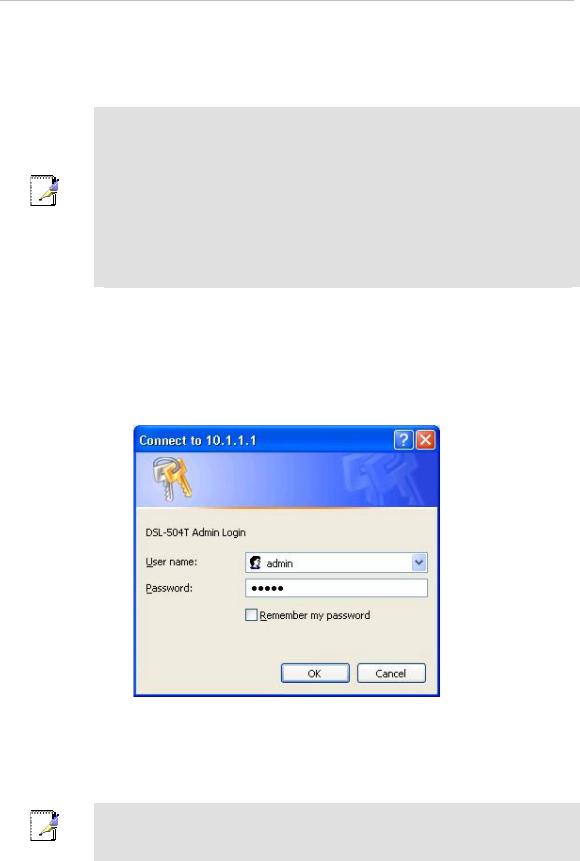
DSL-504T DSL Router User’s Guide
Access the Configuration Manager
Now that your computer’s IP settings allow it to communicate with the Router, you can access the configuration software.
Be sure that the web browser on your computer is not configured to use a proxy server in the Internet settings. In Windows Internet Explorer, you can check if a proxy server is enabled using the following procedure:
1. In Windows, click on the Start button, go to Settings and choose Control Panel. 2. In the Control Panel window, double-click on the Internet Options icon.
Note |
3. Click the Connections tab and click on the LAN Settings button. |
|
4.Verify that the “Use proxy server” option is NOT checked. If it is checked, click in the checked box to deselect the option and click OK.
Alternatively, you can access this Internet Options menu using the Tools pull-down menu in Internet Explorer.
Login to Home Page
To use the web-based management software, launch a suitable web browser and direct it to the IP address of the Router. Type in http:// followed by the default IP address, 10.1.1.1 in the address bar of the browser. The URL in the address bar should read: http://10.1.1.1.
A dialog box prompts for the User Name and Password. Type in the default User Name admin and default Password admin and click the OK button to access the web-based manager.
Enter Password
You should change the web-based manager access user name and password once you have verified that a connection can be established. The user name and password allows any PC within the same subnet as the Router to access the web-based manger.
The user name and password used to access the web-based manager isNOT the same as the
ADSL account user name and password needed for PPP connections to access the Internet.
Note
15
